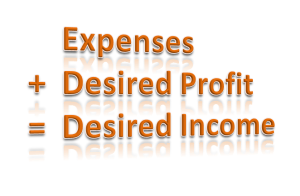 What does it take to run a business? What expenses do you need to consider in order to be successful setting prices and staying in business?
What does it take to run a business? What expenses do you need to consider in order to be successful setting prices and staying in business?
I was recently asked how I went about setting my prices. Well, that’s really a matter of simple math. Of course everyone’s equation will look different, but it’s a matter of understanding your expenses and what you need to end up with at the end of the day/year.
So, let’s look at what it takes to run a business, a successful business. This can certainly vary from industry to industry, but let’s review some of the basics.
Product or Service – First things first; what are you doing or selling? You have to create, develop, or buy a product or service that you intend to sell for profit. This includes the expenses of materials, manufacturing, engineering, researching and developing time.
Location – You need a location. Even if you’re running a home based business, you need to set-up an office with desk and filing space for organization. Some businesses need to rent retail and/or warehouse space.
Marketing – This is a big category. Marketing includes advertising, newsletters, networking, and article submission. It also includes printed items that promote your business, such as: business cards, brochures, postcards, banners, etc. Marketing includes online media, such as: a Blog, Facebook, Twitter, LinkedIn, YouTube, Foursquare, Pinterest, and Google. While not all of these cost money, they certainly take time; and time is money!
Website – While your website is a huge part of marketing, it also serves as the introduction of your business to many potential customers. The design of your site is an important decision. The hosting and URL purchase can drive your email options. It can also provide an ecommerce aspect. You will want to integrate any newsletter, social media, and blogging efforts that you engage in to help drive further business to your website, as well as, provide further information from you to your customers.
Bookkeeping – This covers invoicing clients, making sure bills get paid, reviewing aging receivables, reconciling the accounts, and handling any payroll.
Operations – What systems will you have in place to make your job easier? What will the process look like when someone chooses to work with you? What will the follow-up entail? Who will be responsible for each aspect and step in the process?
Administration – The day to day items that take you away from the product or service you are trying to sell. This can include emailing, scheduling, data entry, filing, scanning paperwork, typing and sending letters, etc.
Security – How will you protect your inventory and/or information? Will you need a security system, spyware for your computer, a backup system?
Legal – This covers setting up your business entity, creating contracts, reviewing risk and compliance, and any litigation.
Staffing – Employees are a HUGE expense, including HR, salaries, medical benefits, employment taxes, overhead, equipment, training, interviewing, managing, and professional development.
After looking at this basic list, you can see that running a business is not just about how much time you spend making your widget or providing your service. Each of the categories above can equate to multiple expenses that will eat into your bottom line if you don’t plan for them.
Running a real, sustainable business involves a lot of thought, planning, and expenses. My advice is to consider all the costs, and create a budget before setting up shop and setting prices.
Helpful Hint: As an entrepreneur, 30% – 50% of your time may not be spent on billable activities, so setting your prices based on a 40 hour work week may not be realistic.


Comments
Pingback: Is trying to ‘keep up with the Joneses’ bringing you down?